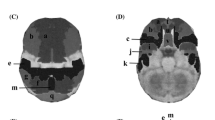Abstract
Cholinesterase inhibitors improve or stabilize cognitive impairment in patients with Alzheimer’s disease (AD). The purpose of this study was to detect brain perfusion changes and the effects of rivastigmine, an acetylcholinesterase inhibitor on single photon emission computed tomography (SPECT) before and after treatment. Fifteen patients who fulfilled the clinical criteria for probable AD of mild to moderate severity, as put forth by the National Institute of Neurological and Communicative Disorders and Stroke—Alzheimer’s Disease and Related Disorders Association, and as specified by theDiagnostic and Statistical Manual of Mental Disorders, Fourth Edition, were included in the study. A control group of 15 healthy individuals from the same age and education range was included in the study. Before treatment was begun, Mini Mental State Examination (MMSE) tests were performed on all patients to evaluate cognitive function. All patients underwent baseline SPECT for evaluation of 25 different brain regions. Rivastigmine 3 mg/d was given for the first 4 wk of treatment; the dosage was then increased to 6 mg/d. The MMSE and SPECT were repeated 6 mo after the start of treatment. SPECT findings revealed that rivastigmine did not significantly affect brain perfusion in AD cases except in the inferior frontal lobe, despite stabilization and improvement noted in MMSE scores during treatment. Rivastigmine treatment of patients with AD did not significantly change brain perfusion as seen on SPECT, except in the inferior frontal lobe, but cognitive performance was stabilized or improved during the treatment course. These findings suggest the need for additional, larger studies to investigate the effects of acetylcholinesterase inhibitors on regional cerebral blood flow.
Similar content being viewed by others
References
McKhann G, Drachman D, Folstein M, Katzman R, Price D, Stadlan EM. Clinical diagnosis of Alzheimer’s disease: report of the NINCDS-ADRDA work group under the auspices of Department of Health and Human Services Task Force on Alzheimer’s disease.Neurology. 1984; 34: 939–944.
Davies P. Neurotransmitter-related enzymes in senile dementia of the Alzheimer type.Brain Res. 1979; 171: 319–327.
Ingvar DH, Risberg J, Schwartz MS. Evidence of subnormal function of association cortex in presenile dementia.Neurology. 1975; 25: 964–974.
Ichimiya A. Functional and structural brain imagings in dementia.Psychiatry Clin Neurosci. 1998; 52(suppl): S223-S225.
Frackowiak RS, Pozzilli C, Legg NJ, et al. Regional cerebral oxygen supply and utilization in dementia.Brain. 1981; 104: 753–778.
Friedland RP, Brun A, Budinger TF. Pathological and positron emission tomographic correlations in Alzheimer’s disease.Lancet. 1985; 1: 228.
deLeon MJ, George AE, Ferris SH, et al. Positron emission tomography and computed tomography assessments of the aging human brain.J Comput Assist Tomogr. 1984; 8: 88–94.
Foster NL, Chase TN, Mansi L, et al. Cortical abnormalities in Alzheimer’s disease.Ann Neurol. 1984; 16: 649–654.
Benson DF, Kuhl DE, Phelps ME, Cummings JL, Tsai SY. Positron emission tomography in the diagnosis of dementia.Trans Am Neurol Assoc. 1981; 106: 68–71.
Folstein M. The Mini-Mental State Examination. In: Crook T, Ferris SH, Bartus R, eds.Assessment in Geriatric Psychopharmacology. New Canaan: Mark Powley Associates; 1983: 47–51.
American Psychiatric Association.Diagnostic and Statistical Manual of Mental Disorders, 4th ed. Washington, DC: American Psychiatric Association; 1994.
Kasa P, Papp H, Kasa P Jr, Torok I. Donepezil dose-dependently inhibits acetylcholinesterase activity in various areas and in the presynaptic cholinergic and the postsynaptic cholinoceptive enzyme positive structures in the human and rat brain.Neuroscience. 2000; 101: 89–100.
Mosconi L. Brain glucose metabolism in the early and specific diagnosis of Alzheimer’s disease: FDG-PET studies in MCI and AD.Eur J Nucl Med Mol Imaging. 2005; 32: 486–510.
Nobili F, Koulibaly M, Vitali P, et al. Brain perfusion follow-up in Alzheimer’s patients during treatment with acetylcholinesterase inhibitors.J Nucl Med. 2002; 43: 983–990.
Brown DR, Hunter R, Wyper DJ, et al. Longitudinal changes in cognitive function and regional cerebral function in Alzheimer’s disease: a SPECT blood flow study.J Psychiatr Res. 1996; 30: 109–126.
Pearlson GD, Harris GJ, Powers RE, et al. Quantitative changes in mesial temporal volume, regional cerebral blood flow cognition in Alzheimer’s disease.Arch Gen Psychiatry. 1992; 49: 402–408.
Harris GJ, Links JM, Pearlson GD, Camargo EE. Cortical circumferential profile of SPECT cerebral perfusion in Alzheimer’s disease.Psychiatr Res. 1991; 40: 167–180.
Furey ML, Pietrini P, Haxby JV. Cholinergic enhancement and increased selectivity of perceptual processing during working memory.Science. 2000; 290: 2315–2319.
Warren S, Hier DB, Pavel D. Visual form of Alzheimer’s disease and its response to anticholinesterase therapy.J Neuroimaging. 1998; 8: 249–252.
Nakano S, Asada T, Matsuda H, et al. Donepezil hydrochloride preserves regional cerebral blood in patients with Alzheimer’s disease.J Nucl Med. 2001; 42: 1441–1445.
Tune L, Tiseo PJ, Ieni J, et al. Donepezil HCl (E2020) maintains functional brain activity in patients with Alzheimer’s disease: results of a 24-week, double-blind, placebo-controlled study.Am J Geriatr Psychiatry. 2003; 11: 169–177.
Vennerica A, Shanks MF, Staff RT, et al. Cerebral blood flow and cognitive responses to rivastigmine treatment in Alzheimer’s disease.Neuroreport. 2002; 13: 83–87.
Ceravolo R, Volterrani D, Tognoni G, et al. Cerebral perfusional effects of cholinesterase inhibitors in Alzheimer’s disease.Clin Neuropharmacol. 2004; 27: 166–170.
Staff RT, Gemmell HG, Shanks MF, et al. Changes in the rCBF images of patients with Alzheimer’s disease receiving donepezil therapy.Nuc Med Communications. 2000; 21: 37–41.
Author information
Authors and Affiliations
Corresponding author
Rights and permissions
About this article
Cite this article
Cerci, S.S., Tamam, Y., Kaya, H. et al. Effect of rivastigmine on regional cerebral blood flow in Alzheimer’s disease. Adv Therapy 24, 611–621 (2007). https://doi.org/10.1007/BF02848786
Issue Date:
DOI: https://doi.org/10.1007/BF02848786




